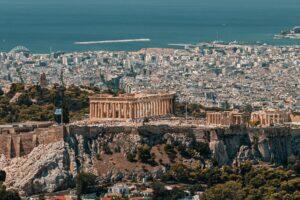Fodor's Expert Review Roman Agora
The city's commercial center from the 1st century BC to the 4th century AD, the Roman Market was a large rectangular courtyard with a peristyle that provided shade for the arcades of shops. Its most notable feature is the west entrance's Bazaar Gate, or Gate of Athena Archegetis, completed around AD 2; the inscription records that it was erected with funds from Julius Caesar and Augustus. Halfway up one solitary square pillar behind the gate's north side, an edict inscribed by Hadrian regulates the sale of oil, a reminder that this was the site of the annual bazaar where wheat, salt, and oil were sold. On the north side of the Roman Agora stands one of the few remains of the Turkish occupation, the Fethiye (Victory) Mosque. The eerily beautiful mosque was built in the late 15th century on the site of a Christian church to celebrate the Turkish conquest of Athens and to honor Mehmet II (the Conqueror). During the few months of Venetian rule in the 17th century, the mosque... READ MORE
The city's commercial center from the 1st century BC to the 4th century AD, the Roman Market was a large rectangular courtyard with a peristyle that provided shade for the arcades of shops. Its most notable feature is the west entrance's Bazaar Gate, or Gate of Athena Archegetis, completed around AD 2; the inscription records that it was erected with funds from Julius Caesar and Augustus. Halfway up one solitary square pillar behind the gate's north side, an edict inscribed by Hadrian regulates the sale of oil, a reminder that this was the site of the annual bazaar where wheat, salt, and oil were sold. On the north side of the Roman Agora stands one of the few remains of the Turkish occupation, the Fethiye (Victory) Mosque. The eerily beautiful mosque was built in the late 15th century on the site of a Christian church to celebrate the Turkish conquest of Athens and to honor Mehmet II (the Conqueror). During the few months of Venetian rule in the 17th century, the mosque was converted to a Roman Catholic church; it is now closed to the public.
Surrounded by a cluster of old houses on the western slope of the Acropolis, the world-famous Tower of the Winds (Aerides) is now open to the public for visits. Located inside the Roman Agora, it is the most appealing and well preserved of the Roman monuments of Athens, keeping time since the 1st century BC. It was originally a sundial, water clock, and weather vane topped by a bronze Triton with a metal rod in his hand, which followed the direction of the wind. Its eight sides face the direction of the eight winds into which the compass was divided; expressive reliefs around the tower personify these eight winds, called I Aerides (the Windy Ones) by Athenians. Note the north wind, Boreas, blowing on a conch, and the beneficent west wind, Zephyros, scattering blossoms.
READ LESS







